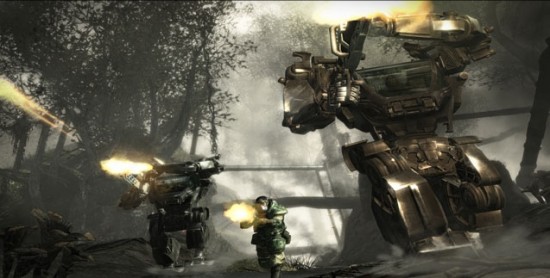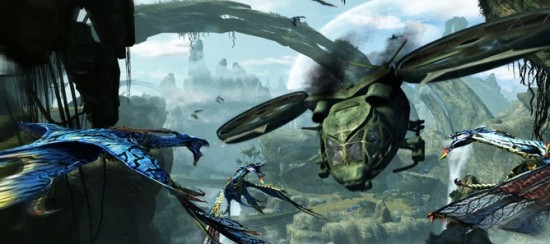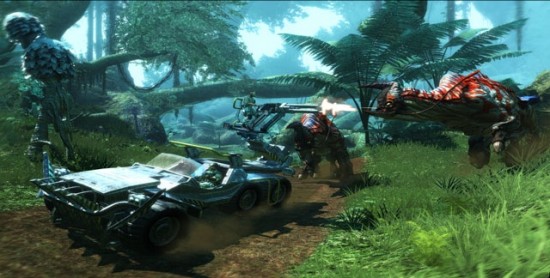The details about James Cameron's Avatar have been closely guarded, to say the least. When I sat down in UbiSoft's tiny Avatar theater on the E3 show floor, I was treated to far more information about the movie than I expected to get. As Peter mentioned recently, producer Jon Landau was on hand to discuss how the film went from a story written fourteen years ago by Cameron to the cutting edge movie being edited now. But Landau actually explained (more or less) the whole movie to us. That was a surprise, especially since Cameron had just made two public appearances (at the UbiSoft press conference and at a screening of Aliens and The Abyss) and revealed no specifics about Avatar. Want to know more?
Read on after the jump, but beware: there are many potential spoilers within.

The story begins on Earth. Jake Sully (Sam Worthington) is a soldier who hasn't found anything worth fighting for. Adding injury to insult, he's lost the use of his legs. So when the opportunity comes to travel to the planet Pandora and work with a mining operation there, Jake accepts.
What's on Pandora that is so important? A mineral, found nowhere else, that is a game-changer with respect to energy production. Befitting the mineral's status as a MacGuffin, Landau jokingly called it 'unobtanium'. Pandora is a lush but harsh planet. The air is poisonous to humans. Plants and creatures alike are predatory and very dangerous. And the natives, ten-foot tall blue humanoids called Na'vi, aren't exactly pleased about the men and machinery that are scarring the surface and digging to find the unobtanium.
Because the planet is so harsh, traditional armor and envirosuit solutions have been insufficient to protect miners. A sort of clone program has developed in which DNA from humans and Na'vi are combined. The result is essentially a cloned Na'vi that can house the consciousness of an individual with human DNA that matches the original clone material. Jake Sully's brother had been the original donor and controller for one such avatar. But he's been killed, so the corporation has asked Jake to come to Pandora to pilot the (very expensive) body, as he's got matching DNA. The upshot for Jake: he'll be able to walk again.

So the story flashes forward a few years to the point where Jake has arrived on Pandora. He finds a place of indescribable beauty, where the forests are dense with wild colors and forms, and the flora and fauna bioluminesce at night, creating a dreamlike garden of wonders. Floating mountains dot the sky above 900 foot tall trees. As Jake is working for the mining corporation he has an encounter with a ViperWolf, one of Pandora's many dangers. Before he can be savaged, an arrow pierces the animal, saving him. It's been fired by a female Na'vi (Zoe Saldana), though whom Jake begins to learn about the real workings of Pandora.
The Na'vi live in an idealistic harmony with Pandora's dangers. Through his savior, Jake begins to see the human mining efforts in a new light. He realizes that he's found something worth fighting for. But joining the Na'vi in a battle against the human invaders comes with a terrible price: he can't stay within his avatar forever. When the avatar sleeps, Jake wakes up in his human body, and must use an interface to rejoin his consciousness and the avatar. If he joins the Na'vi at war with the humans, he'll lose the option to rejoin his avatar, and therefore be stuck as an immobile human without that Na'vi he's grown to love.

So where does this take me? To several conclusions and assumptions:
Landau said that, if Titanic had more than a bit of Romeo and Juliet in it, Avatar has more than a little bit of Pocahontas. That tells you quite a lot about the nature of the story, if it wasn't already clear. The movie almost sounds like Cameron's version of a Terrence Malick movie, with heavy shades of Dances With Wolves. The man versus nature scenario isn't terribly subtle, nor is the positioning of the Na'vi as analogs for Native Americans. Also apparent is Cameron's youthful fascination for Edgar Rice Burroughs and the John Carter of Mars books.
I ran into Landau after the presentation, and only had a moment to ask questions. I asked if there was a contradiction in the way he'd described the film as more of a character story and even a romance than a movie about the planet and technology. If it was really this emotional story at the core, why not make it a decade or more ago, when the story was originally written? His answer confirmed what most of us have assumed: that the real importance here is not the 3D, but the believability of the Na'vi. We have to accept that these beings and all the creatures and plants around them are as real as Sam Worthington's human character. We have to accept that a largely digital ten-foot blue alien is a creature capable of expressing the range and depth of emotion of a human. Landau claims this has been achieved.
A handful of scenes from the film (about 25 minutes) have been screened to very select groups of individuals over the last week or two. I've talked to several people who saw Fox's heavily guarded presentation, and though they were very respectful of their NDAs, basic comments were all similar: mind-blowing. Game-changer. Dreamlike. Completely unlike anything they'd seen before. One or two of the people I spoke to are not the most objective when it comes to something like this. But a couple others were people whose opinions I trust almost implicitly. That they were so taken with the footage says a lot.
The point highlighted most often by those who saw the film footage was the incredible look of Pandora at night, when bioluminescent plants and creatures create a totally alien landscape. Not too difficult to see the influence of Cameron's underwater documentary work there. But I was also reminded of descriptions of Gaspar Noe's new film that appeared at Cannes, Enter the Void. The selective praise for that movie focused on its first hour, in which a hallucinatory, dreamlike landscape gave audiences a very new and unexpected vision of Tokyo. How amused I'll be if the Cameron and Noe movies turn out to be spiritually linked based on their dreamlike nighttime wanderings.
The revelation of the power suit that we've been buzzing about for a week is also amusing, as the tech seems more and more like a small part of the film, something that calls back to the familiar Aliens and can ease people into learning about Avatar. I don't doubt that we'll see plenty of power suits in the war against the powerful ten-foot Na'vi, but having that be the first big 'revelation' of the film's marketing campaign is really a huge bit of misdirection.
About the game: it does not follow the movie. You'll be able to play both a human marine and a Na'vi, through which you'll explore both the destructive mining and clearing operations and the battles to save Pandora from defilement. The game uses the same creature and vehicle models as the film, and includes both designs developed by Cameron's crew that went unused in the movie and things that Cameron's people designed based on the desires of UbiSoft's team.
If Avatar succeeds, definitely expect Cameron to live in this universe for a while. The potential for at least one sequel was mentioned more than once, and both film and game are positioned to set off a chain of franchises. Given that this is being called the first massive sci-fi film universe since Star Wars that has been uniquely created by one director, that's not a surprise.
E3 photo thanks to DMatias



